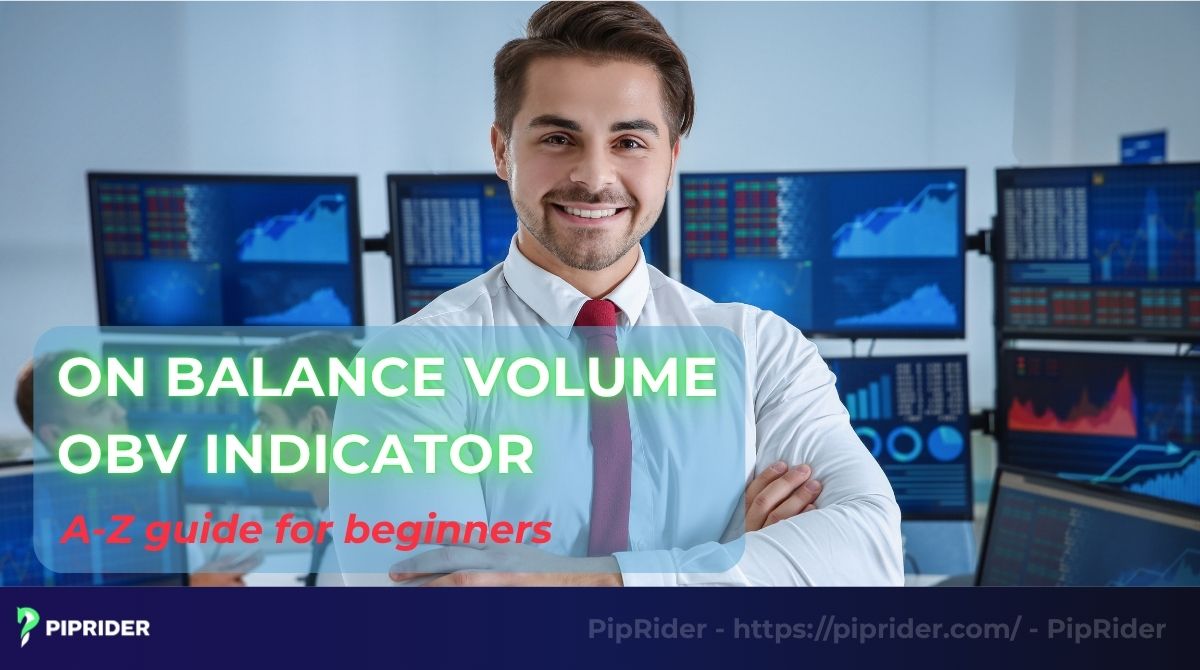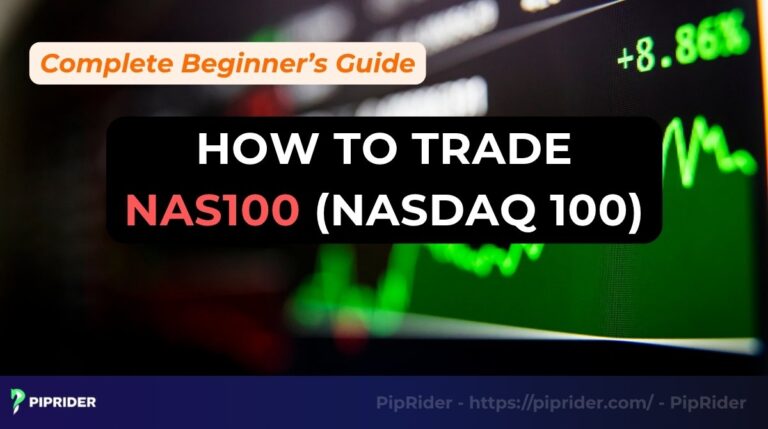Failed breakouts frequently occur when price movements are not supported by the necessary trading volume. The On-Balance Volume OBV indicator is a momentum tool designed to measure cumulative buying and selling pressure within an asset. By tracking this volume flow, OBV helps traders verify the conviction behind a price trend.
This guide provides a direct analysis of the OBV calculation and presents practical strategies for trend confirmation and identifying unreliable price signals.
Key Takeaways
- On Balance Volume uses trading activity to measure buying/selling pressure and anticipate price movements.
- Its core principle is that volume precedes price, so a major change in this indicator can signal an upcoming price move.
- Most powerful signals are trend confirmation and disagreements with price.
- A number from this tool is irrelevant; only its direction and trend matter.
- This indicator should be used as a confirmation tool to validate price action and breakouts, not as a standalone signal.
1. What is the On Balance Volume OBV indicator?
The On Balance Volume (OBV) is a cumulative momentum indicator that tracks the net flow of trading volume into or out of a financial asset. It provides a visualized representation of the total cumulative buying and selling pressure over a specified period.
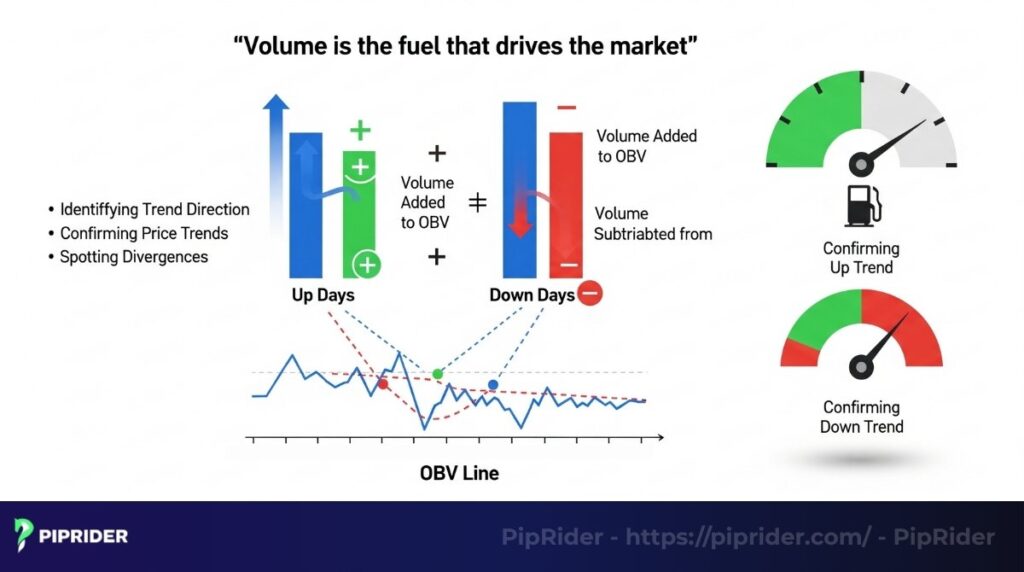
The OBV indicator was developed by legendary analyst Joseph Granville in his 1963 book, “Granville’s New Key to Stock Market Profits.” He was one of the first to truly popularize the idea of tracking volume flow as a leading indicator of price (Investopedia, n.d.).
Granville’s core belief was simple yet profound: volume is the fuel that drives the market. A price move that occurs on low transaction levels is suspect and may not have the strength to continue. Conversely, a price move backed by a surge in trading volume is a sign of strong conviction.
The calculation is straightforward: the indicator maintains a cumulative total, adding a day’s activity on up days and subtracting a day’s activity on down days, producing a single line that represents overall buying and selling pressure (StockCharts, n.d.).
2. The On Balance Volume Formula
OBV’s formula is simple, built on a straightforward logic that anyone can grasp, yet provides profound insight.
2.1. The Core Logic
The indicator works by keeping a running total of market activity based on one simple set of rules:
- When a given day’s closing price is higher than the previous day’s, the entire volume for that day is added to the indicator’s running total.
- If today’s closing price is lower than yesterday’s, sellers are assumed to be in control, so we subtract today’s activity from the previous total.
- If the closing price is unchanged, the line remains the same.
2.2. The OBV Formula
Based on that logic, the On Balance Volume formula can be written like this:
If Current Close > Previous Close:
| OBV = Previous OBV + Current Volume |
If Current Close < Previous Close:
| OBV = Previous OBV- Current Volume |
If Current Close = Previous Close:
| OBV = Previous OBV |
The OBV line on a chart is simply the result of this calculation being repeated, day after day, creating a cumulative total.
2.3. A Simple Example
Let’s walk through a quick example to see it in action. The indicator’s starting value doesn’t matter; only its direction does. Let’s assume a starting value of 10,000.
| Day | Closing Price | Price Change | Volume | Calculation | Resulting Value |
| 1 | $100 | – | 1,000 | (Starting Value) | 10,000 |
| 2 | $102 | Up | 1,200 | 10,000 + 1,200 | 11,200 |
| 3 | $101 | Down | 800 | 11,200 – 800 | 10,400 |
| 4 | $101 | Unchanged | 500 | 10,400 + 0 | 10,400 |
| 5 | $103 | Up | 1,500 | 10,400 + 1,500 | 11,900 |
The final number (11,900) is completely arbitrary. What matters is that the line’s trend is upwards, confirming that buying activity was dominant over selling over this period.
3. How to Read and Analyze OBV Signals
Here, the On Balance Volume indicator transitions from a simple line on a chart to a powerful analytical tool. Remember, the line’s actual numerical value is meaningless. Its price direction is the only thing that matters.
The indicator gives three primary types of signals, and learning to spot them can give a trader a significant edge.
3.1. Trend Confirmation: A Basic Check
This is the most straightforward way to use the indicator, and it should become a constant habit. A trader is simply checking to see if volume agrees with the volume-price trend.
- Bullish Confirmation: For a healthy uptrend, both the price chart and the line should create a series of higher highs and higher lows. This alignment indicates that increasing activity is fueling the price increase, signaling a robust and sustainable trend.
- Bearish Confirmation: Conversely, a strong downtrend is confirmed when both price and On Balance Volume are simultaneously forming lower lows and lower highs.
If the indicator isn’t confirming the trend, it’s an immediate red flag that something is wrong under the surface, a key insight into market dynamics.
3.2. Divergences: The Most Powerful OBV Signal
Divergences occur when the indicator’s direction disagrees with the price’s direction, often acting as a powerful early warning of potential price shifts.
- Bearish Divergence (a sell signal): happens when price pushes to a new high, but the line fails to make a new high. This is a huge warning sign. It tells a trader that even though price looks strong, the volume behind the move is weak, suggesting institutional investors aren’t participating and the trend is running out of fuel.
- Bullish Divergence (a buy signal): forms when the price chart prints a new low, while the line simultaneously carves out a higher low. This is a very positive sign, suggesting sellers are becoming exhausted and buyers are quietly accumulating positions, even as price is falling.
3.3. Breakout Confirmation: Separating Real Moves from Fakeouts
The price dramatically breaks a key resistance level, traders jump in with a buy order, and then it immediately reverses.
The indicator is a trader’s best tool for avoiding this trap. For a breakout to be considered genuine and sustainable, it must be supported by a significant increase in cumulative volume.
The Confirmation Signal:
- Before trading a price breakout, look at the On Balance Volume. Has the line already broken out of its own corresponding trendline or resistance level?
- When the line breaks out ahead of or concurrently with the price, it strongly suggests genuine buying activity is powering the move.
- However, if the price breaks out while OBV remains stagnant or declines, it serves as a major warning sign of a potential fakeout.
4. Four OBV Trading Strategies for the Forex Market
A signal is just an observation; a strategy is a complete plan with rules for entry, exit, and risk management.Here are four simple yet effective ways to incorporate the On Balance Volume indicator into trading.
4.1. The OBV Trend-Following Strategy
Trend-following is the most foundational of all on balance volume trading strategies. It’s designed to ensure a trader is always on the side of dominant volume pressure.
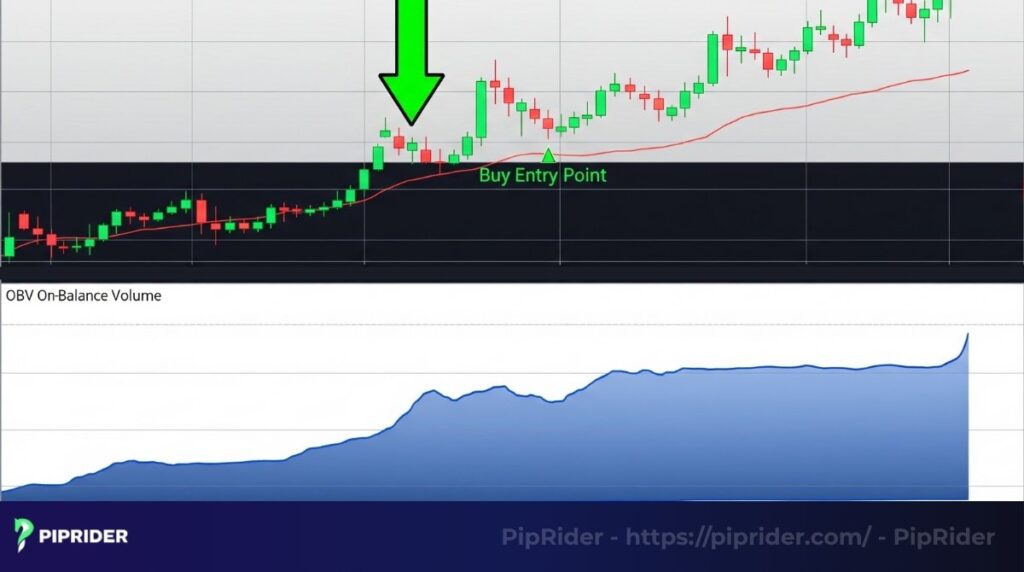
Based on the chart above, traders can use the line’s trend as the primary directional filter. If the line is in an uptrend, only look for buy opportunities. If the line is trending down, exclusively search for selling opportunities.
- The Rules for a Buy Trade:
- Identify the trend: Traders must first confirm that the line itself is in a distinct uptrend, creating higher highs and higher lows.
- Wait for a pullback: Observe as the market makes a temporary dip, creating a better entry point.
- Entry: Enter a buy trade when the value starts to resume its uptrend, as long as the OBV’s uptrend remains intact.
- Stop loss should be positioned underneath the most recent swing low.
4.2. The OBV Divergence Reversal Strategy
This reversal strategy can identify potential trend reversals at an early stage by leveraging its most powerful signal.

On the chart above, a disagreement between price and the indicator is a powerful sign that a trend is exhausted. This strategy aims to enter a trade as the old trend dies and a new one begins.
- The Rules for a Bearish Reversal (sell trade):
- Spot the sell pattern: The value must make a new high while the indicator makes a lower high.
- Confirm on chart: This is crucial. Wait for the market itself to show weakness, such as a break of a key support level or a down-trending candle pattern like an evening star.
- Entry: Only take a sell position after the chart has validated the reversal signal.
- Stop loss: Place the stop loss just beyond the recent peak.
4.3. The OBV and Moving Average Combo Strategy
The OBV and Moving Average Combo strategy combines the indicator’s volume analysis with classic trend analysis of a moving average to create a powerful confluence.
Use a moving average to define the primary trend. Then, consult On Balance Volume to validate the strength of the activity behind that trend.
- The Rules for a Buy Trade:
- Trend filter: The market must be trading above a 50 EMA.
- Volume confirmation: The indicator’s line must also be in an uptrend, confirming that volume supports the bullish move.
- Entry: Find a buy entry on a pullback to the 50 EMA, but only if the line remains in its uptrend.
4.4. The OBV Breakout Confirmation Strategy
The breakout confirmation strategy is designed specifically to help avoid those frustrating fakeouts.
A true price breakout must be supported by a breakout in volume. If trading activity doesn’t participate, the move is likely a trap.
- The Rules for a Bullish Breakout:
- First, identify a key resistance level on your price chart. Draw a similar level on the OBV chart.
- Wait for the breach: Ideally, you want to see the line cross its own resistance ahead of price. This is a leading indicator that buying activity is building up under the surface.
- Entry: You can then enter a buy trade once the value follows through and breaks its corresponding resistance.
- Stop loss: Place your stop loss below the breached level.
5. How to Set Up and Use the OBV on MT4 and MT5
One of the best things about this technical indicator is that, unlike some custom tools, it comes as a standard, built-in tool on nearly every trading platform, including MetaTrader 4 and MetaTrader 5.
Getting it onto your chart is a very simple process that takes less than a minute. The process is virtually identical for both platforms.

- Open the indicator list: From the main menu in your MT4 or MT5 platform, navigate to ‘Insert’ and then hover over ‘Indicators’.
- Select the “Volumes” category: A new menu will appear. Find and click on the Volumes sub-category.
- Choose the indicator: From the final list, simply click on On Balance Volume.
- Confirm the settings: A small settings window will pop up. The tool is very straightforward; the default settings are the only ones you’ll ever need. Within the “Colors” tab, you have the option to adjust the color and thickness of the line for better visibility.
- Apply to chart: Click OK. The indicator will now appear as a single line in a separate panel at the bottom of your price chart, ready for analysis.
There are no complex parameters to worry about, which is part of this indicator’s beauty. Its power comes from simple and direct interpretation, not from endless tweaking of settings.
6. The Limitations of the OBV Indicator
No tool in a trader’s kit is perfect, and the On Balance Volume indicator certainly has its own set of limitations. Understanding where it can fail you is just as important as knowing its strengths. Ignoring them can lead to costly mistakes.
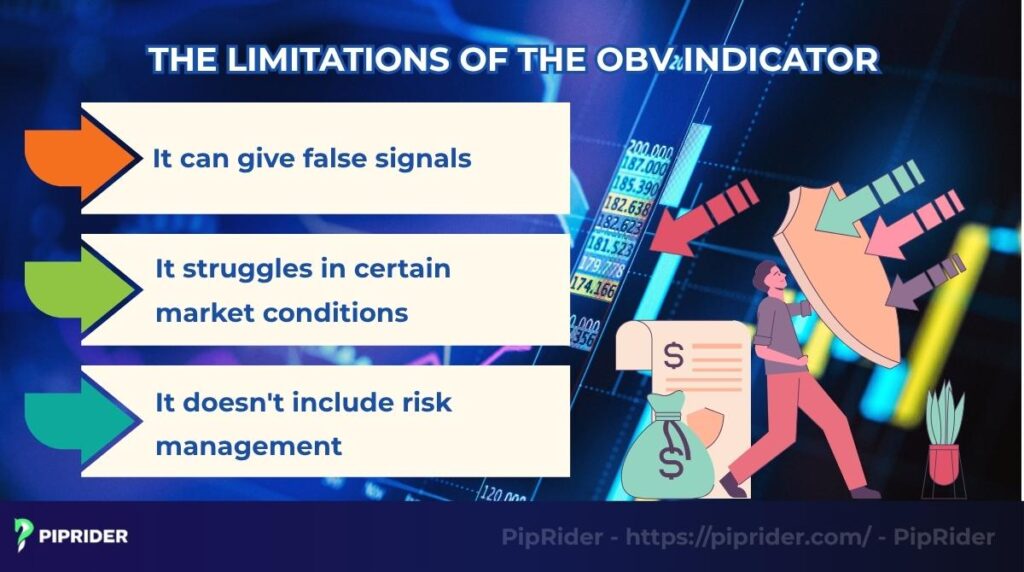
6.1. It Can Give False Signals
The indicator’s calculation is very simple, and this can sometimes be a weakness. A single, massive spike in average daily trading volume on a news event can throw the line way off, creating a sharp move that doesn’t reflect the true, underlying trend of accumulation or distribution.
Tip: A smooth, gradual trend in the OBV line indicates strong and sustained market conviction. Conversely, abrupt, vertical spikes are less reliable and reflect unsustainable volume flow.
6.2. It Struggles in Certain Market Conditions
The indicator is designed to analyze trends and the volume driving them. Therefore, it tends to lose its predictive value in very low-volume, sideways, or choppy markets where liquidity and volatility are thin.
In these conditions, the line will often just wiggle back and forth without any clear direction, making it impossible to get a reliable signal.
Tip: The OBV indicator is designed for trending markets. Its signals are unreliable and often erratic during periods of sideways price consolidation.
6.3. It Doesn’t Include Risk Management
The OBV can give a powerful hint about what might happen next, but it tells a trader nothing about where to place a stop loss or when to take profit. This is true for most lagging indicators.
Tip: OBV serves only as a secondary confirmation tool and must not be used for isolated entry signals. Core trade parameters (entry, stop-loss, take-profit) must be determined by price action analysis.
7. Frequently Asked Questions (FAQ)
Here are some quick, straight-to-the-point answers to questions retail investors see traders ask most often about the On Balance Volume indicator.
8. Conclusion
The On Balance Volume (OBV) is a key volume indicator used to validate the sustainability of price movements by tracking cumulative buying and selling pressure. Its primary utility is trend confirmation, and it must always be combined with structured price action analysis to improve trade reliability and filter out false signals.
The knowledge you’ve gained today is a crucial step in learning to read the market more deeply. To continue building on this foundation, we invite you to follow us here at Piprider and explore our comprehensive best technical indicators category.


